Gangue Source Reduction Technology and Process Optimization Based on Underground Coal Gangue Photoelectric Separation
Abstract
:1. Introduction
2. Underground Sorting Methods of Gangue
3. Key Technology of Underground Coal Gangue Photoelectric Separation
3.1. Accurate Identification Mechanism of Coal and Gangue
3.1.1. Testing Plan
3.1.2. Test Results and Discussion
3.2. Highly Efficient Jet Separation of Coal and Gangue
3.2.1. Numerical Simulation and Optimization of Jet Nozzle Parameters
3.2.2. Calculation Results and Discussion
3.3. Process Layout of Underground Coal Gangue Photoelectric Separation System
3.3.1. Technical Characteristics of Coal Gangue Photoelectric Separation System Underground Layout
3.3.2. Technological Process of Underground Coal Gangue Photoelectric Separation System
4. Engineering Application of Underground Coal Gangue Photoelectric Separation System
4.1. Background of the Engineering Application
4.2. Engineering Application Scheme
4.2.1. Centralized Layout Type
4.2.2. Distributed Layout Type
4.2.3. Mobile Layout Type
5. Conclusions
- The characteristic spectral lines of montmorillonite, α-quartz, and kaolinite crystals are identified via the X-ray absorption fine structure (XAFS) method. The results show that the absorption coefficient μ(E) of Al and Si atoms in minerals is significantly different, and the XAFS method has the ability to identify different minerals, thus achieving accurate identification of coal and gangue under X-ray.
- The numerical simulation results of four commonly used nozzles for coal gangue jet separation showed that the streamlined nozzle has the longest jet core area, the slowest jet velocity attenuation, and the lowest gas consumption per unit time, and its performance is better than the other three types of nozzles.
- In this paper, the technical characteristics of the coal gangue photoelectric separation system are expounded, and the technological layout of the separation system is explored. Based on the exploiting and mining systems of Renjiazhuang Coal Mine, three layout types of the coal gangue photoelectric separation system are designed: centralized layout type, decentralized layout type, and mobile layout type, and the advantages and disadvantages of each type are obtained and compared.
Author Contributions
Funding
Data Availability Statement
Acknowledgments
Conflicts of Interest
References
- Zhang, J.; Miao, X. Underground disposal of waste in coal mine. J. China Univ. Min. Technol. 2006, 35, 197–200. [Google Scholar]
- Zhang, K.; Li, J. The treatment of mine waste rock at underground. J. North China Inst. Sci. Technol. 2005, 2, 46–47. [Google Scholar]
- Zhang, J.; Ju, F.; Li, M.; Zhou, N.; Zhang, Q. Method of coal gangue separation and coordinated in-situ backfill mining. J. China Coal Soc. 2020, 45, 131–140. [Google Scholar]
- Zhang, J.; Tu, S.; Cao, Y.; Tan, Y.; Xi, H.; Pang, J. Coal gangue intelligent separation and backfilling technology and its engineering application in underground coal mine. J. China Univ. Min. Technol. 2021, 50, 417–430. [Google Scholar]
- Zhang, J.; Zhang, Q.; Ju, F.; Zhou, N.; Li, M.; Zhang, Q. Theory and technique of greening mining integrating mining, separating and backfilling in deep coal resources. J. China Coal Soc. 2018, 43, 377–389. [Google Scholar]
- He, Q. Research on Key Technique of the Integration of Separation and Backfilling in Coal Mining. Master’s Thesis, China University of Mining and Technology, Xuzhou, China, 2014. [Google Scholar]
- Zhang, H.; Zhang, Q.; Zuo, X.; Wu, Z.; Fan, W.; Liu, H.; Tian, X. Design and application of mining-separation-backfilling system for mining ecological and environmental protection. J. China Univ. Min. Technol. 2021, 50, 548–557. [Google Scholar]
- Dou, D.; Wu, W.; Yang, J.; Zhang, Y. Classification of coal and gangue under multiple surface conditions via machine vision and relief-SVM. Powder Technol. 2019, 356, 1024–1028. [Google Scholar] [CrossRef]
- Liu, Y.; Zhang, Z.; Liu, X.; Wang, L.; Xia, X. Performance evaluation of a deep learning based wet coal image classification. Miner. Eng. 2021, 171, 107126. [Google Scholar] [CrossRef]
- Hajialimohammadi, A.; Edgington-Mitchell, D.; Honnery, D.; Montazerin, N.; Abdullah, A.; Agha Mirsalim, M. Ultra high speed investigation of gaseous jet injected by a single-hole injector and proposing of an analytical method for pressure loss prediction during transient injection. Fuel 2016, 184, 100–109. [Google Scholar] [CrossRef]
- Wang, Y.; Wang, X.; Zhang, Z.; Li, Y.; Liu, H.; Zhang, X.; Hočevar, M. Optimization of a self-excited pulsed air-water jet nozzle based on the response surface methodology. Stroj. Vestn.-J. Mech. E 2021, 67, 75–87. [Google Scholar] [CrossRef]
- Cao, Y.; Liu, M.; Xing, Y.; Li, G.; Luo, J.; Gui, X. Current situation and prospect of underground coal preparation technology. J. Min. Saf. Eng. 2020, 37, 192–201. [Google Scholar]
- Deng, J.; Kuang, Y.; Zhao, J.; Sun, X.; Wang, C. Intelligent control strategy for the separation process of dense medium cyclone. J. China Univ. Min. Technol. 2019, 48, 624–632. [Google Scholar]
- Miao, X.; Zhang, J. Key technology of integration of coal mining-gangue washing-backfilling and coal mining. J. China Coal Soc. 2014, 39, 1424–1433. [Google Scholar]
- Zhou, C.; Liu, X.; Zhao, Y.; Yang, X.; Li, Y.; Dong, L.; Duan, C.; Rao, Z. Recent progress and potential challenges in coal upgrading via gravity dry separation technologies. Fuel 2021, 305, 121430. [Google Scholar] [CrossRef]
- Zhou, E.; Yan, G.; Weng, X.; Zhang, Z.; Zhao, P.; Zhang, B. A novel and low cost coal separation process: Combination of deep screening classification and gravity separation. Powder Technol. 2020, 367, 568–575. [Google Scholar] [CrossRef]
- Boylu, F.; Talı, E.; Çetinel, T.; Çelik, M.S. Effect of fluidizing characteristics on upgrading of lignitic coals in gravity based air jig. Int. J. Miner. Process. 2014, 129, 27–35. [Google Scholar] [CrossRef]
- Zhu, X.; Tao, Y.; Sun, Q.; Man, Z. The low efficiency of lignite separation by an enhanced gravity concentrator. Energy Sources Part A Recover. Util. Environ. Eff. 2017, 39, 835–842. [Google Scholar] [CrossRef]
- Zhang, Q.; Zhang, J.; Wu, Z.; Chen, Y. Overview of Solid Backfilling Technology Based on Coal-Waste Underground Separation in China. Sustainability 2019, 11, 2118. [Google Scholar] [CrossRef]
- Gülcan, E.; Gülsoy, Ö.Y. Performance evaluation of optical sorting in mineral processing—A case study with quartz, magnesite, hematite, lignite, copper and gold ores. Int. J. Miner. Process. 2017, 169, 129–141. [Google Scholar] [CrossRef]
- Zhang, Y.; Yoon, N.; Holuszko, M.E. Assessment of coal sortability and washability using dual energy X-ray transmission system. Int. J. Coal Prep. Util. 2022, 42, 2895–2907. [Google Scholar] [CrossRef]
- Zhang, Y.; Zhu, H.; Zhu, J.; Ou, Z.; Shen, T.; Sun, J.; Feng, A. Experimental study on separation of lumpish coal and gangue using X-ray. Energy Sources Part A Recover. Util. Environ. Eff. 2021, 1–13. [Google Scholar] [CrossRef]
- He, L.; Wang, S.; Guo, Y.; Hu, K.; Cheng, G.; Wang, X. Study of raw coal identification method by dual-energy X-ray and dual-view visible light imaging. Int. J. Coal Prep. Util. 2023, 43, 361–376. [Google Scholar] [CrossRef]
- Zeng, Q.Y.; Xie, J.; Zhou, W.; Zhu, J.B.; Liu, L.L.; Yin, J.Q.; Zhu, W.L. Study of the Crystallographic Distortion Mechanism during the Annealing of Kaolinite. Minerals 2022, 12, 994. [Google Scholar] [CrossRef]
- Liu, J. Optimization of Jet Pump Nozzle Shrinkage Angle. Master’s Thesis, Jiangsu University, Zhenjiang, China, 2013. [Google Scholar]
- Yan, L. Design and Test of Jet Separation Device in Plastic near Infrared Separation System. Master’s Thesis, Qingdao University of Science and Technology, Qingdao, China, 2018. [Google Scholar]
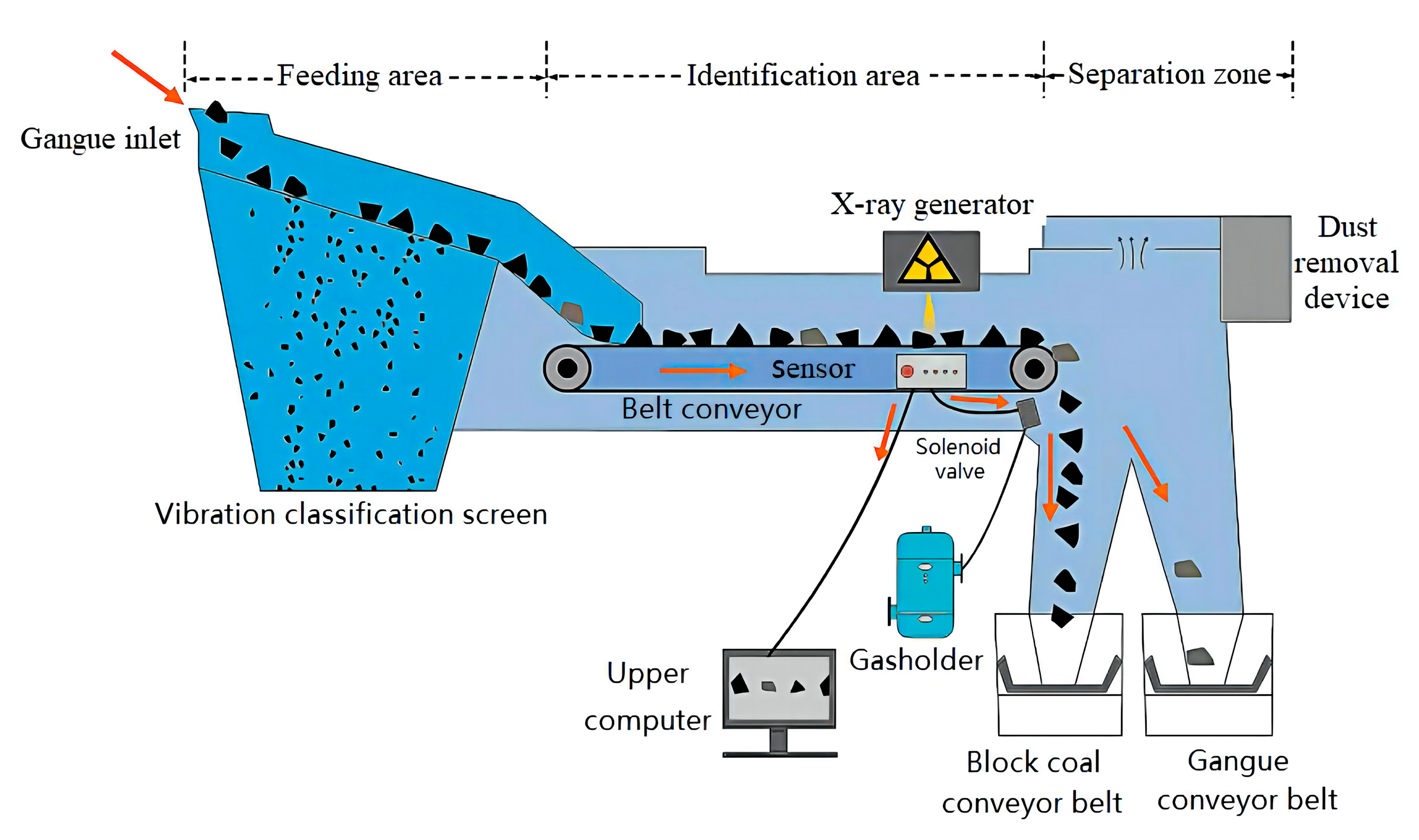
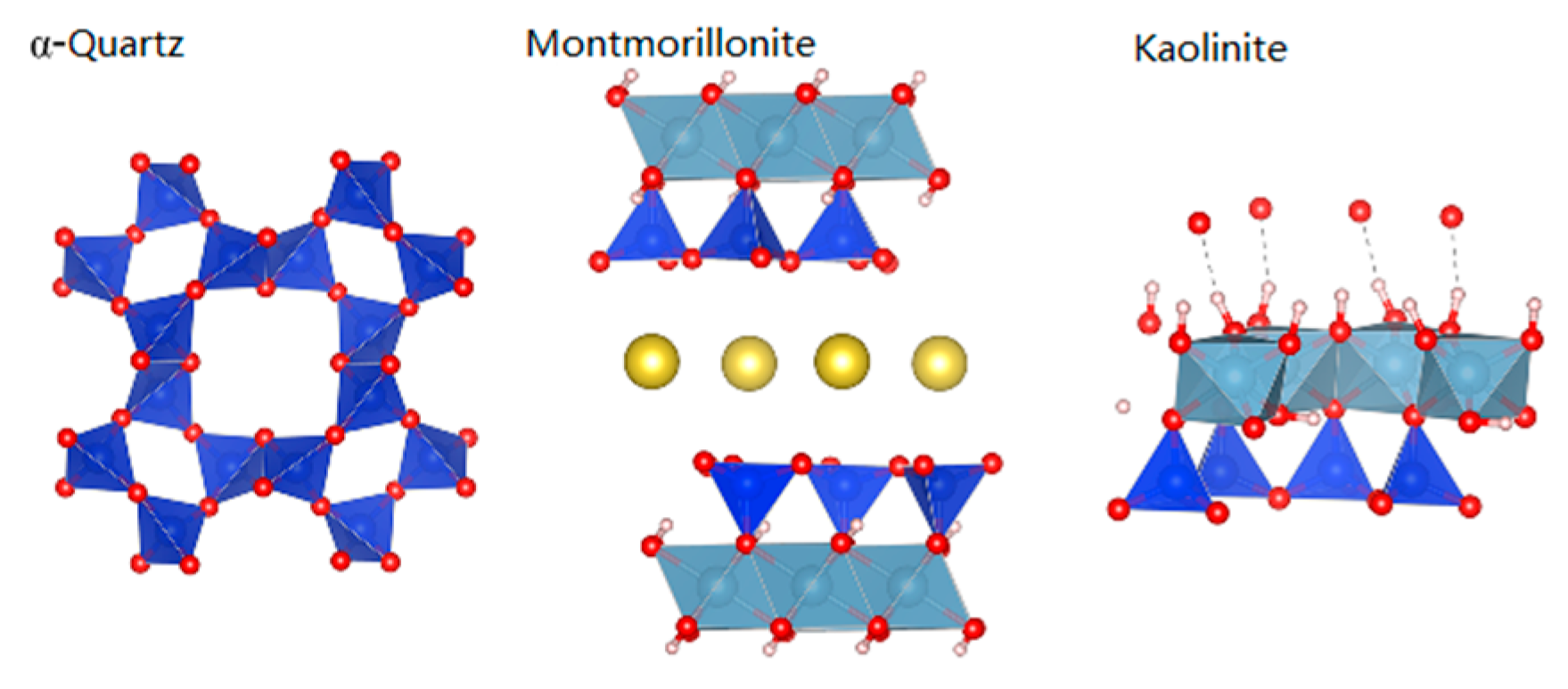

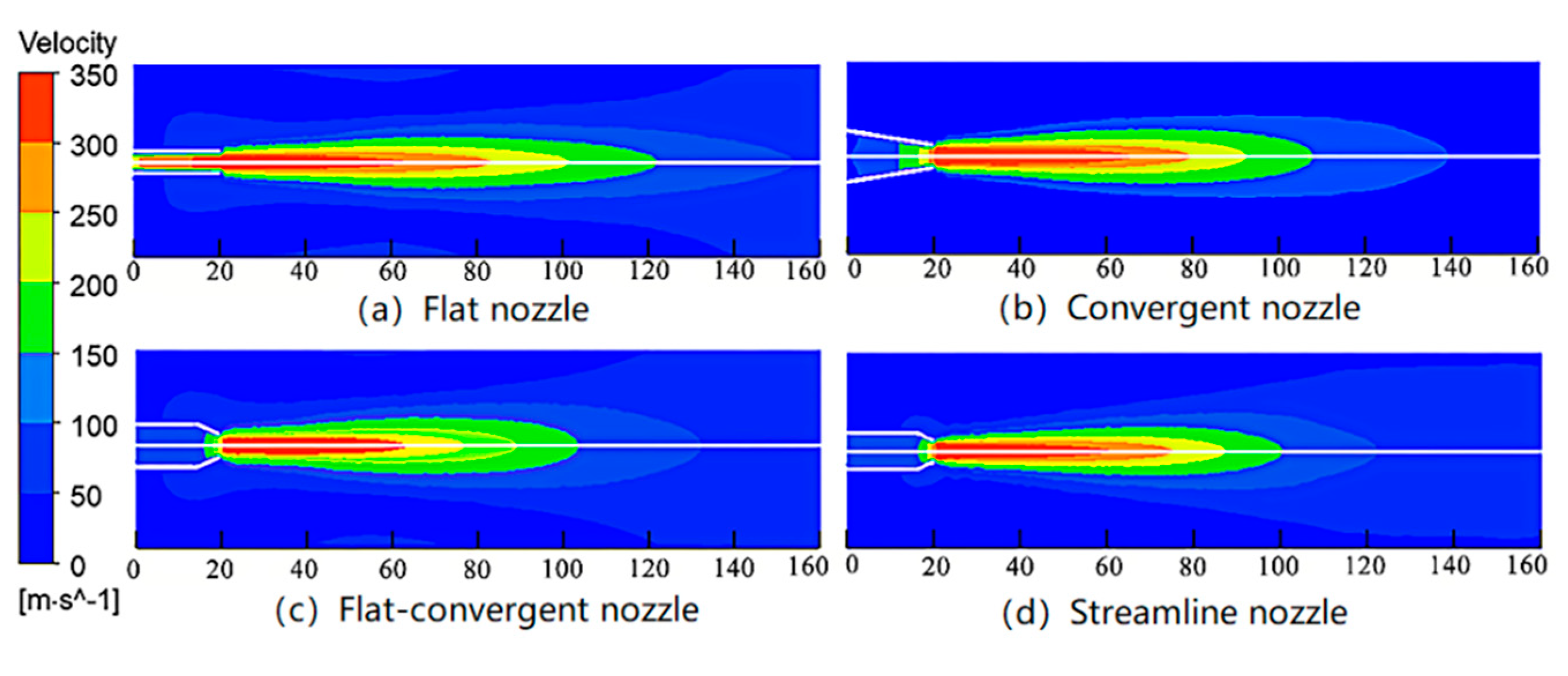
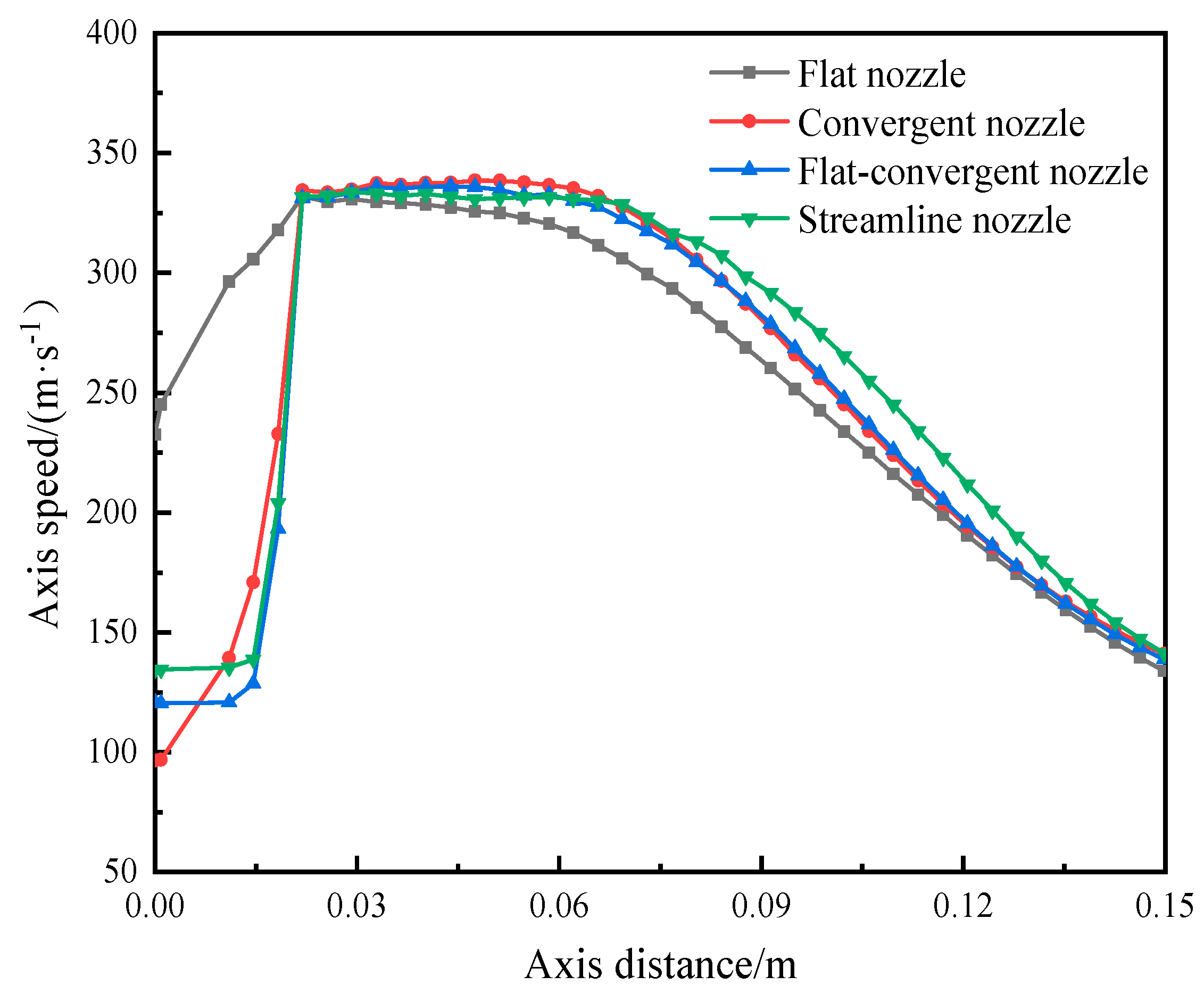
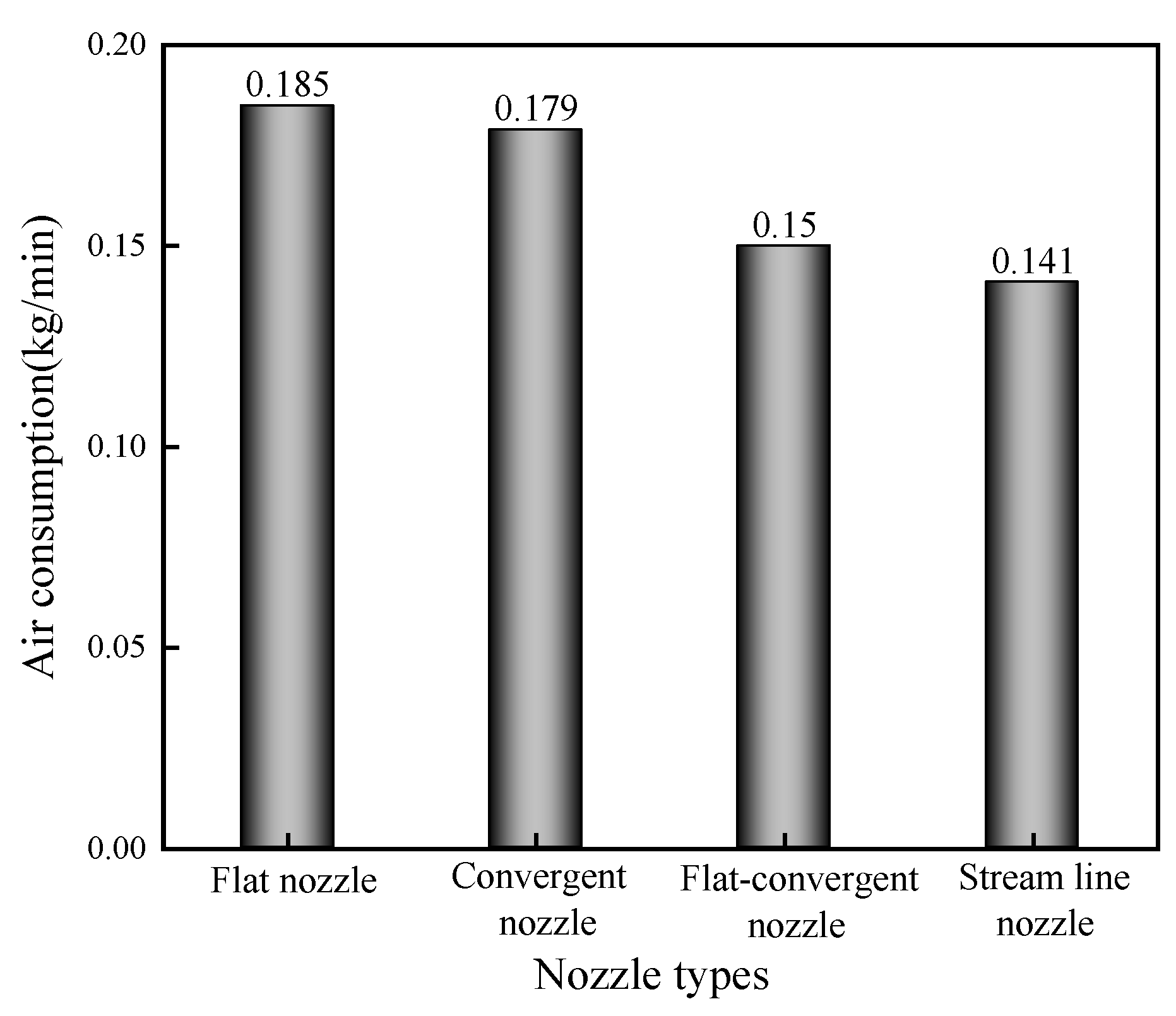



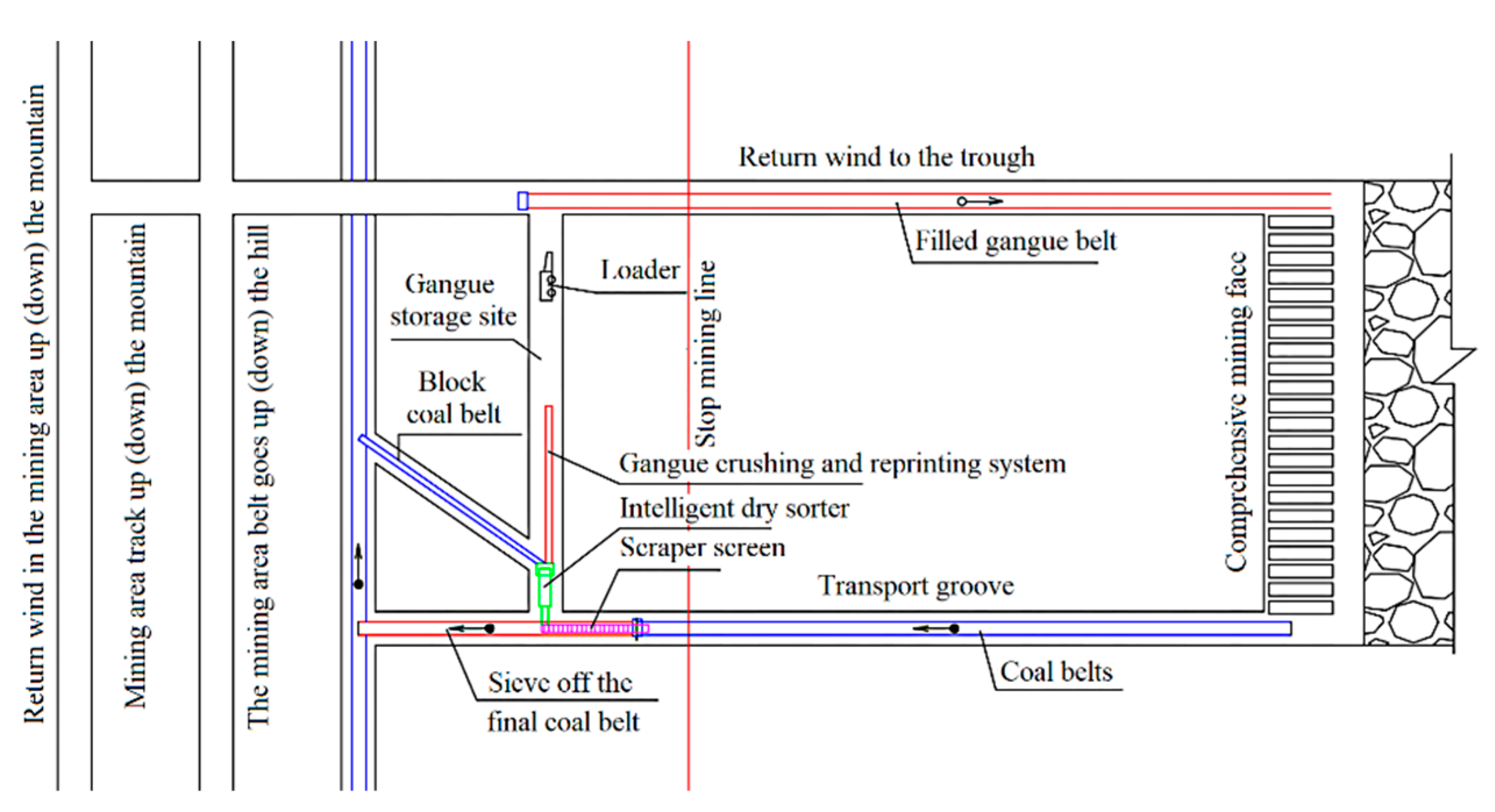
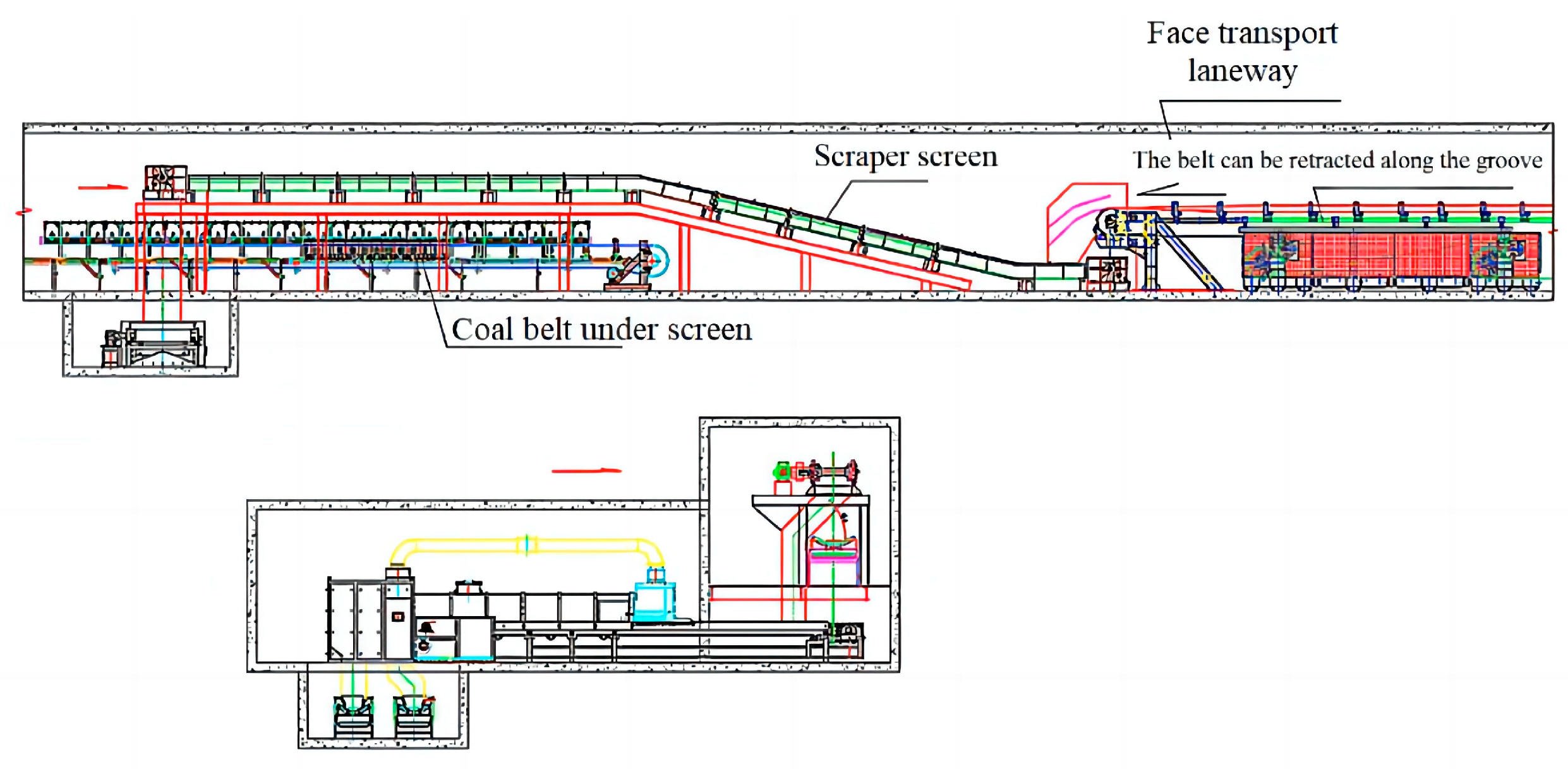

| Project | Heavy Medium Shallow Groove Separation | Moving Sieve Jigging Separation | Air Chamber Jigging Separation |
|---|---|---|---|
| Separation methods | Wet separation | Wet separation | Wet separation |
| Feeding size/(mm) | 300–25 | 300–25 | 150–25 |
| Processing capacity of a single device /(t/h) | 300 | 60–110 | 280–380 |
| Floor space/(m2) | 30 | 36 | 35 |
| Main equipment | Classifying screen, heavy medium shallow tank separator, crusher, medium drainage screen, magnetic separator, hydrocyclones, slime high-frequency screen, etc. | Classifying screen, moving jigger, crusher, pressure filter, etc. | Classifying screen, air chamber underbed jig, crusher, etc. |
| Layout | Chamber | Chamber | Chamber |
| Implementation site | Jiyang Coal Mine of Shandong Xinwen Mining Group; Xinjulong Coal Mine; Zhaizhen Coal Mine | Xiezhuang Coal Mine of Shandong Xinwen Mining Group; Linyi Coal Mine; Tangshan Coal Mine of Kailuan Group | Xingdong Coal Mine of Jizhong Energy Group |
| Items | Centralized Layout Type | Distributed Layout Type | Mobile Layout Type |
|---|---|---|---|
| Position | Upper entrance of the coal bunker in the shaft station. | Near the stopping line in the working face haulage roadway. | Haulage roadway of working face. |
| Main chamber | The underground coal bunker needs to be renovated. It is necessary to build a new coal gangue photoelectric separation chamber, a lump coal bunker, and a gangue bunker. Affects the normal production of the mine for about 1 month. | Most of the transportation roadway needs to be repainted. New coal gangue photoelectric separation chamber and lump coal belt roadway need to be established. Does not affect normal production. | Most of the transportation roadway needs to be repainted. New gangue bunker needs to be established. Does not affect normal production. |
| Merits and demerits | (1) Good system operating environment and convenient maintenance of equipment. (2) The gangue processing mode after selection is flexible, which can be filled after mining or directly in the haulage roadway. (3) Gangue can be centrally treated. (4) Long transportation lines and high costs. (5) It is necessary to build a new chamber and transform the existing coal bunker. | (1) Poor operating environment. (2) The gangue filling method is not flexible. (3) Each working face needs to arrange a system, which has scattered management and low efficiency. (4) Short transportation distance and low cost of gangue before and after treatment. (5) It can make full use of coal seam roadway without building large chamber. | (1) Poor system operating environment. (2) It is difficult to transfer and fill gangue. (3) Modular design is required. (4) The equipment can be moved, the gangue transportation line is short, and the cost is low. (5) The system layout is difficult and the stability requirements are demanding. |
Disclaimer/Publisher’s Note: The statements, opinions and data contained in all publications are solely those of the individual author(s) and contributor(s) and not of MDPI and/or the editor(s). MDPI and/or the editor(s) disclaim responsibility for any injury to people or property resulting from any ideas, methods, instructions or products referred to in the content. |
© 2023 by the authors. Licensee MDPI, Basel, Switzerland. This article is an open access article distributed under the terms and conditions of the Creative Commons Attribution (CC BY) license (https://creativecommons.org/licenses/by/4.0/).
Share and Cite
Zhou, W.; Xia, W.; Liu, L.; Li, L.; Zeng, Q.; Wang, S.; Zhu, J. Gangue Source Reduction Technology and Process Optimization Based on Underground Coal Gangue Photoelectric Separation. Processes 2023, 11, 2519. https://doi.org/10.3390/pr11092519
Zhou W, Xia W, Liu L, Li L, Zeng Q, Wang S, Zhu J. Gangue Source Reduction Technology and Process Optimization Based on Underground Coal Gangue Photoelectric Separation. Processes. 2023; 11(9):2519. https://doi.org/10.3390/pr11092519
Chicago/Turabian StyleZhou, Wei, Wanghao Xia, Liangliang Liu, Liansheng Li, Qiuyu Zeng, Shujie Wang, and Jinbo Zhu. 2023. "Gangue Source Reduction Technology and Process Optimization Based on Underground Coal Gangue Photoelectric Separation" Processes 11, no. 9: 2519. https://doi.org/10.3390/pr11092519
APA StyleZhou, W., Xia, W., Liu, L., Li, L., Zeng, Q., Wang, S., & Zhu, J. (2023). Gangue Source Reduction Technology and Process Optimization Based on Underground Coal Gangue Photoelectric Separation. Processes, 11(9), 2519. https://doi.org/10.3390/pr11092519






